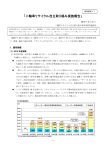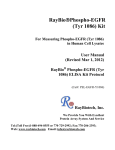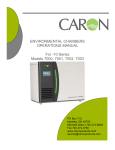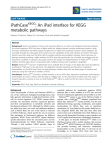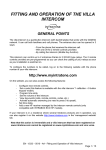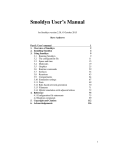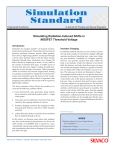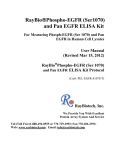Download this Methods for Molecular Biology paper
Transcript
Chapter 26 Spatial and Stochastic Cellular Modeling with the Smoldyn Simulator Steven S. Andrews Abstract This chapter describes how to use Smoldyn, which is a computer program for modeling cellular systems with spatial and stochastic detail. Smoldyn represents each molecule of interest as an individual point-like particle. These simulated molecules diffuse, interact with surfaces (e.g., biological membranes), and undergo chemical reactions much as they would in real biochemical systems. Smoldyn has been used to model signal transduction within bacterial cells, pheromone signaling between yeast cells, bacterial carboxysome function, diffusion in crowded spaces, and many other systems. A new “rule-based modeling” feature automatically generates chemical species and reactions as they arise in simulations due to protein modifications and complexation. Smoldyn is easy to use, quantitatively accurate, and computationally efficient. It is generally best for systems with length scales between nanometers and several microns, time scales from tens of nanoseconds to tens of minutes, and up to about 105 individual molecules. Smoldyn runs on Macintosh, Linux, or Windows systems, is open source, and can be downloaded from http://www.smoldyn.org. Key words: Computational biology, Smoldyn, Particle-based simulation, Spatial modeling, Rulebased modeling 1. Introduction Computational modeling is becoming an important cell biology research method. Modeling is useful for quantitatively testing hypotheses about systems of interest, helping analyze and interpret experimental data, and developing a deeper understanding of how biochemical systems function. In these and other roles, simulations have helped elucidate cellular systems such as bacterial chemotaxis (1), the eukaryotic cell cycle (2), and actin-based cellular protrusion (3). Active simulation algorithm research and frequent increases in computer power suggest that cellular modeling will Jacques van Helden et al. (eds.), Bacterial Molecular Networks: Methods and Protocols, Methods in Molecular Biology, vol. 804, DOI 10.1007/978-1-61779-361-5_26, # Springer Science+Business Media, LLC 2012 519 520 S.S. Andrews continue gaining importance for many years to come. Recent articles that review simulation methods and software include (4–7). This chapter describes how to use the Smoldyn simulation program, which simulates biochemical processes with spatial and stochastic detail (8). Smoldyn represents each molecule of interest as an individual point-like particle that has a location in continuous space. Simulated molecules diffuse, undergo chemical reactions, and interact with membranes according to simple biophysical principles and user-specified parameters. Smoldyn is typically best for models with spatial scales from nanometers to microns, temporal scales from tens of nanoseconds to tens of minutes, and up to about 105 individual molecules. The lower ends of these ranges arise from the fact that Smoldyn does not represent excluded volumes, orientations, or momenta of simulated molecules. These limit Smoldyn’s spatial resolution to a few molecular radii and temporal resolution to molecules’ rotational diffusion time constants (9, 10). The upper ends of the ranges arise from the fact that Smoldyn is too computationally intensive to simulate much larger systems conveniently on current desktop computers (however, recent work on parallelizing Smoldyn for graphics processing units is starting to enable larger simulations). Smoldyn’s level of simulation detail is ideally suited for modeling intracellular organization. More specifically, the so-called particle-based simulation method that Smoldyn uses (along with ChemCell (11) and MCell (12)) has proven useful for modeling single-molecule tracking experiments (13, 14), molecular diffusion in restricted environments (15–17), stochastic signaling noise that arises from spatial organization (6, 8, 18), and the causes and effects of protein localization (19, 20). As some examples, Lipkow and coworkers developed several Smoldyn simulations of intracellular signal transduction for Escherichia coli chemotaxis. Each model included about ten different proteins and about ten chemical reactions. Using these simulations, they found that intracellular crowding accentuates signaling differences to different flagellar motors (17), that the CheZ phosphatase is likely to change its intracellular location upon cellular stimulation (19), and that stable concentration gradients are likely to arise for the CheY signal transducer (20). In another example (Fig. 1), several colleagues and I used Smoldyn to help understand why haploid yeast cells that secrete the pheromone-degrading protease Bar1 are better able to discriminate between potential mating partners than yeast cells that do not secrete Bar1 (21). We found that Bar1 sharpens the local pheromone concentration gradient because pheromone is progressively inactivated as it diffuses through a Bar1 cloud (8). This model included four proteins, six chemical reactions, and about 2 105 individual molecules; it also covered about 7,000 mm3 of volume, simulated about 75 min of time, and took 26 Spatial and Stochastic Cellular Modeling with the Smoldyn Simulator 521 Fig. 1. A model of the effect of the Bar1 protease on yeast signaling. The mesh surface on the outside of the system is a triangulated spherical boundary that absorbs molecules with Smoldyn’s “unbounded-emitter” method. The central sphere is a “receiver” cell which is covered with 6,622 receptors (red if bound to pheromone and blue if not, in online version), light gray spheres are “challenger” cells which secrete pheromone slowly, and the dark gray sphere on the right is a “target” cell which secretes pheromone quickly. Green (light gray in print version) dots are Bar1 proteins and black dots are pheromone molecules. This model showed that the pheromone-degrading Bar1 protease improves yeast mating partner discrimination by sharpening the pheromone concentration gradient. Republished with permission from ref. 8. The supplementary information for the original publication presents the model parameter selection process unusually thoroughly. about 10 h to run. As a final example, Savage is using Smoldyn to investigate carbon transport and fixation in cyanobacteria, which takes place in organelle-like carboxysomes (Fig. 2). His model includes several partially transmitting surfaces. Within the field of particle-based simulation, Smoldyn is notable for its high accuracy and good computational efficiency (8). Each Smoldyn algorithm is either exact or nearly exact for any length simulation time step, and complete Smoldyn simulations approach exactness as time steps are reduced toward zero (18, 22, 23) (by definition, exact simulation methods produce results that are theoretically indistinguishable from those of the underlying model system). Smoldyn achieves relatively high computational efficiency through judicious approximations for simulating chemical reactions (22) and molecule–surface interactions (23), and through data structures that reduce unnecessary computations. 522 S.S. Andrews Fig. 2. A model of carboxysome function in a cyanobacterium. The wireframe outside surface depicts the cell membrane (internally, Smoldyn represents it as a smooth continuous surface). The four large green spheres are carboxysomes, which are organelle-like proteinaceous compartments that contain the carbon-fixation apparatus of cyanobacteria. Smaller red dots are carbon dioxide molecules and larger light blue dots are 3-phosphoglycerate molecules. Savage and coworkers are using this model to investigate the roles of compartmentalization and spatial organization in carbon fixation. 2. Materials Smoldyn is available at http://www.smoldyn.org. The distribution includes the program source code, complete installation instructions, a user’s manual, a programmer’s manual, example files, and several utility programs. The Smoldyn User’s Manual is much more thorough than this chapter and should be consulted for statement syntax, available options, and all other details. Smoldyn is open source and runs on Macintosh, Linux, and Windows computers (however, the Windows version does not support rulebased modeling, described in Subheading 3.10). Faster computers run simulations faster, of course, although laptops or desktops up to about 5 years old are often adequate. Smoldyn runs from a shell prompt, which most operating systems supply with a “Terminal” or “Command Prompt” application. Installation on Mac or Linux computers is typically as easy as changing to the Smoldyn download directory and typing ./configure, make, and sudo make install at a shell prompt. For Windows, the download includes a prebuilt Smoldyn executable and all necessary “dll” files. Smoldyn support is available at the on-line forum http://www. smoldyn.org/forum, or via e-mail at [email protected]. 3. Methods 3.1. Running Smoldyn Run Smoldyn by typing smoldyn myfile.txt at a shell prompt, where myfile.txt is your configuration file name. You can also append option flags to this command, such as -o to suppress text 26 Spatial and Stochastic Cellular Modeling with the Smoldyn Simulator 523 output, -p to just display parameters, or -t for text-only operation. Upon starting, Smoldyn reads model parameters from your configuration file, calculates and displays simulation parameters, and runs the simulation. As the simulation runs, Smoldyn displays the simulated system to a graphics window and/or saves quantitative data to one or more output files. Smoldyn stops when the simulation is complete. Box 1 presents an example configuration file and its output. 3.2. The Configuration File Smoldyn configuration files are plain text files. The first word of each line tells Smoldyn which parameters to set and the rest of the line lists those parameters, separated by spaces or tabs. Usually, the statement sequence does not matter. When it does, it is usually obvious; for example, molecular species need to be defined before their diffusion coefficients. Smoldyn displays error messages and terminates if it cannot parse the configuration file. Denote comments in your configuration file with a “#” symbol, or bracket multiple comment lines with /* and */. Ideally, your comments should list the model name, its author or authors, its creation and modification dates, citations to relevant references, and the model’s distribution terms; if so, your model will obey the “minimum information requested in the annotation of biochemical models” (MIRIAM) (24), which aids model sharing and reuse. Your comments should also list the model units, such as microns and seconds, or nanometers and microseconds. This is because Smoldyn does not assume any particular units, but instead requires that all parameters use the same units. For example, if you choose microns and seconds, then you will need to enter diffusion coefficients in mm2/s, first order reaction rate constants in s1, and second order reaction rate constants in mm3/s. See Table 3.2.1 of the Smoldyn User’s Manual. Use read_file to separate your model description into multiple configuration files. This can be useful for separating lists of surface or molecule information from the main model file, or for separating fixed model components from ones you wish to vary. End each configuration file with end_file. Several macro statements that substitute text “tokens” with replacement text can simplify model development. These include define, define_global, undefine, ifdefine, ifundefine, else, and endif. In a typical use, you would collect the model parameters that you wish to explore to the top of your configuration file with define statements and then refer to them later on by their token names (see Box 1). 3.3. Space and Time Specify whether your system is 1-, 2-, or 3-dimensional with dim. For example, you could model protein motion along cytoskeletal filaments in one dimension, processes on cell membranes 524 S.S. Andrews Box 1. A sample configuration file and its output. The sections of the configuration file match those in Methods. The snapshot was saved from Smoldyn’s graphical output at 2 seconds. The dynamics were graphed with Microsoft Excel from data that Smoldyn saved to box1out.txt. Below, S is substrate, E is enzyme, ES is enzyme-substrate complex, and P is product 26 Spatial and Stochastic Cellular Modeling with the Smoldyn Simulator 525 with two dimensions, or cellular systems with three dimensions. Low-dimensional models can also approximate higher dimensional ones. Define the system’s spatial extent with boundaries. This does not limit the simulated space but, provided that you keep all molecules within these boundaries, helps Smoldyn run efficiently. Internally, Smoldyn uses the boundaries to spatially partition the system volume so as to reduce the number of molecule–molecule and molecule–surface interactions that it has to investigate (see Note 1 for partition optimization). If your model does not include surfaces (Subheading 3.7), then specify how molecules should interact with the boundaries. The options are reflection, transmission, absorption, or periodic (periodic means that molecules that diffuse out of one side of the system are immediately diffused into the opposite side of the system, which can avoid edge effects in effectively infinite systems). On the other hand, if your model includes any surfaces, then the boundaries defined here will only transmit molecules and you will have to use surfaces to confine molecules. Specify the simulation starting time, stopping time, and time step with time_start, time_stop, and time_step. Smoldyn only supports fixed-length time steps, in contrast to the adaptive time steps that MCell supports (12) or the event-based time steps that the Green’s Function Reaction Dynamics method uses (25). However, you can change time steps midsimulation with the settimestep command (Subheading 3.6). See Note 2 for advice on choosing time steps. 3.4. Molecules Each Smoldyn molecule is a member of a chemical species, and all molecules of a particular species are equivalent. Enter individual species names with species statements. Distinct forms of a molecule, such as phosphorylated and unphosphorylated, or monomeric and dimeric, need to be defined as separate species. To simplify the definitions for these multiple molecular forms, Smoldyn can automatically enumerate both them and their chemical reactions using rule-based modeling (Subheading 3.10). Each molecule, regardless of its species, may be in any of five states. “Solution” state, in which molecules are not bound to surfaces, is the default. Molecules can also bind surfaces in a “front,” “back,” “up,” or “down” state. The former two options represent molecules that bind a single side of a surface, where typical uses include peripheral membrane proteins, GPI-anchored proteins, or adsorbates. The other two options, up and down, represent surface-spanning molecules, such as ion channels or trans-membrane receptors. The separate up and down states allow one to distinguish whether the protein’s active side faces the surface’s front or back. 526 S.S. Andrews Define the diffusion coefficient for each species and state with See Note 3 for advice on choosing diffusion coefficients. Smoldyn can also diffuse molecules anisotropically (difm statement), such as for confining molecules to a plane or for simulating diffusion in anisotropic environments. In addition, molecular drift in a specified direction (drift statement) can represent molecules in flow systems or around motile cells. For example, you could simulate gel electrophoresis with a combination of diffusion and drift. Internally, Smoldyn keeps track of molecules with a “dead” list of inactive molecules and several “live” lists of simulated molecules. See Note 4 for advice on arranging the live lists. The following statements add molecules to the starting state of your model: mol adds solution phase molecules to either specific or random locations; surface_mol (enter after you define surfaces) adds surface-bound molecules to specific surfaces or regions on surfaces; and compartment_mol (enter after you define compartments) adds solution phase molecules to specific spatial compartments. difc. 3.5. Graphics Smoldyn simulation results can only be visualized as they are computed. While this can be inconvenient for generating publication quality figures, the immediate output is very helpful for model development. You can choose from three levels of rendering quality, or no graphical output at all, using the graphics statement. Because graphical rendering is time-consuming, you can speed simulations up by using low quality rendering or by using graphic_iter to only render graphics periodically. Conversely, you can slow simulations down with graphic_delay. The default background color is white, which you can modify with background_color. For everything else, the default color is black. Color the boundary edges with frame_color, spatial partitions with grid_color, molecules with color, and surfaces with surface name color. You can also set boundary line weights with frame_thickness, spatial partition line weights with grid_thickness, molecule sizes with display_size, surface edge weights with thickness, and surface drawing styles with polygon. With Smoldyn’s best rendering quality, called opengl_better, you can place light sources in the system, including their ambient, diffuse, and specular colors, using light. To make full use of these lights, set surface reflection parameters with shininess. As always, see the Smoldyn User’s Manual for details. Unfortunately, Smoldyn renders partially transparent surfaces poorly. This means that if you want to see 26 Spatial and Stochastic Cellular Modeling with the Smoldyn Simulator 527 what’s inside a surface, such as a cell membrane, it is usually best to render it with a wireframe. You can manipulate Smoldyn’s graphical display during your simulation using key strokes. For example, rotate the system with arrow keys, pan with shift + arrows, zoom in with “¼,” zoom out with “,” or revert to the default view with “0.” Also, the space bar pauses the simulation, “T” saves a TIFF image of the current graphics display, and “Q” quits the simulation. Smoldyn can save movies of simulations as stacks of TIFF files. Again, each image is a simple copy of the graphics window display. To turn on recording, set the number of simulation time steps per image with tiff_iter, name the files with tiff_name, and number the files with tiff_min and tiff_max. ImageJ, QuickTime Pro, and other software programs can assemble TIFF stacks into self-contained movies. 3.6. Runtime Commands Smoldyn includes a “virtual experimenter” who can observe or manipulate the simulated system. You can instruct this virtual experimenter to perform tasks before, during, or after the simulation, including at periodic intervals (see Table 3.6.1 of the Smoldyn User’s Manual). Issue commands using the cmd statement, the timing parameters, the name of the specific task, and any taskspecific parameters. The first class of commands are simulation control commands. Examples are stop and pause, which stop or pause the simulation. Also, keypress mimics the behavior of the user pressing a key (see Subheading 3.5), which can be useful for automating the graphical display. These control commands are particularly useful when combined with conditional commands. For example, the statement “cmd E ifno substrate stop” tells the virtual experimenter to count the number of substrate molecules at every time step and to stop the simulation if none remain. The second class, observation commands, save information about the system to text files. For example, molcount records the number of molecules for each species and molcountspace records histograms of molecule counts along a line in the system, from which concentration profiles can be calculated. A particularly powerful observation command is savesim, which saves the entire simulation state to a Smoldyn-readable configuration file. By saving the simulation state regularly, you can abort a simulation mid-run and then restart it later on. Alternatively, you can equilibrate your model in one simulation, save the result with savesim, and then run other simulations that start from this equilibrated state. All observation commands require that you explicitly declare the output file names with output_files, and also with output_root if you do not want the files to be in your working directory. The output file “stdout” sends the output to the terminal window. To save data to a series of files, number the 528 S.S. Andrews first one with output_file_number and progress to subsequent ones with the incrementfile command. Finally, manipulation commands give you wide latitude to modify the system during the simulation, and not necessarily in accordance with biochemical principles. For example, you can instruct the virtual experimenter to add molecules to the system with pointsource or volumesource, remove molecules from inside spheres with killmolinsphere, or replace a specified fraction of one molecular species in some volume with a different species using replacevolmol. Also, several commands allow you to create fixed concentration inputs to your model, such as fixmolcountonsurf and fixmolcountincmpt. The set command is extremely powerful because you can follow it with essentially any Smoldyn statement. This allows you to add species, reactions, or surfaces, change the simulation time step, or modify your model in many other ways, all mid-simulation. 3.7. Surfaces Unlike biological membranes or other real surfaces, Smoldyn surfaces are infinitely thin. This means that molecules in solution phase, or in “front” or “back” surface-bound states, are always on the front or back side of a surface; also, molecules in “up” or “down” states are always exactly at the surface. Each Smoldyn surface is composed of geometric primitives called panels, which can be triangular, spherical, cylindrical, or other shapes. Along with being convenient and computationally efficient, this representation method is also quite versatile because it allows arbitrarily complex surface geometries, disjoint surfaces (e.g., a collection of vesicles), and/or open surfaces (e.g., the fragmented membrane of a lysed cell). For example, the model shown in Fig. 1 includes four surfaces: (1) a mesh of 480 triangles that surrounds the entire system, (2) a spherical “receiver” cell in the middle, (3) a spherical “target” cell shown toward the right side in dark gray, and (4) five spherical “challenger” cells shown in light gray. Note that this last surface is disjoint. The model shown in Fig. 2 includes two surfaces: (1) the cell membrane, assembled from two hemispheres and a cylinder and (2) four spherical carboxysome protein shells. Define each surface with a block of statements that starts with start-surface and ends with end_surface (you can also enter surface parameters with statements that start with surface and the surface name, but the block format is usually easier). Within this block, Within this block, list each individual panel with panel. list each individual panel with panel. If you want surface-bound molecules to be able to diffuse between neighboring panels, whether they are on the same surface or different surfaces, then list each panel’s neighbors with neighbor. Two utility programs included in the distribution help generate panel and neighbor data. The first, wrl2smol, reads Virtual Reality Modeling Language (VRML) files of triangle mesh data and 26 Spatial and Stochastic Cellular Modeling with the Smoldyn Simulator 529 converts them to lists of triangle panels and their neighbors in Smoldyn format. Mathematica, MatLab, ImageJ, and other programs can generate VRML files. The second utility program, SmolCrowd, generates random arrays of nonoverlapping circles or spheres, which can be useful for modeling macromolecular crowding. Several parameters characterize each surface. These include graphical display parameters, described in Subheading 3.5, and surface–molecule interaction parameters. Many types of interactions are possible. For example, you can make a surface impermeable, transmitting, or irreversibly absorbing for molecules that diffuse into it, and these interactions can differ for different molecular species and the two surface faces. Specify these behaviors with action. Alternatively, specify coefficients for adsorption to, desorption from, or partial transmission through surfaces (23) with rate (see Note 5 for advice on these coefficients). Two molecular pseudo-states, “fsoln” and “bsoln,” allow you to distinguish solution-state molecules on the front side of a surface from solution-state molecules on the back side of a surface. You can also specify rates for transitions between surface-bound states, such as from the front state to the back state. Additionally, you can instruct molecules to change species when they cross a surface; this is particularly useful for models with spatially variable diffusion coefficients, such as between extracellular and intracellular regions, or nonraft and raft regions of membranes. Jump surfaces (defined with action and jump) magically transport molecules from one panel to another. They are useful for adding holes to otherwise impermeable surfaces, such as pores in a nuclear envelope, and for creating periodic boundaries. Finally, unbounded-emitter surfaces (unbounded_emitter statement) irreversibly absorb molecules with coefficients that make internal concentration profiles mimic those that would be seen for an unbounded system (23). The triangulated mesh in Fig. 1 is an unbounded-emitter surface. 3.8. Chemical Reactions Smoldyn supports zeroth, first, and second order chemical reactions, where the order is just the number of reactants. Use zeroth order reactions to add molecules at random locations within the entire system volume or within a compartment (Subheading 3.9) at a roughly constant rate. These violate mass balance and are thus unphysical; however, they are particularly useful for including protein or mRNA synthesis in models but not the respective synthesis machinery. Use first order, or unimolecular, reactions for spontaneous molecular changes, such as protein conformation, dissociation, and decay processes. These are also useful for pseudo-first order reactions, in which one of two reactants (e.g., ATP) is unmodeled and assumed to be constant and uniformly distributed. Use second order, or bimolecular, 530 S.S. Andrews reactions for interactions between pairs of molecules, such as association and enzymatic reactions. Enter reactions with the syntax: “reaction name reactants —> products rate,” where name is the reaction name, reactants and products are lists of species and states that are separated by “+” symbols (use “0” if a list is empty and use the fsoln and bsoln pseudo-states as necessary), and rate is the reaction rate constant. Alternatively, use reaction_surface or reaction_cmpt for reactions that should only occur on specific surfaces or in specific compartments. Smoldyn allows up to 16 products for each reaction. Note 6 offers advice on choosing reaction rate constants and Note 7 describes ways to speed up bimolecular reaction simulation, which is typically Smoldyn’s slowest component. Reversible association reactions, of the form A + B ↔ C, involve an additional complication. When a C molecule dissociates, the new A and B molecules form in close proximity to each other, which makes them especially likely to react with each other. This reaction between dissociation products is called a geminate recombination. Nonspatial treatments of chemical kinetics, including conventional mass-action theory and nonspatial simulations, cannot account for geminate recombinations, so they are often ignored. However, geminate recombinations affect reaction rates both in real systems and in particle-based simulations. For example, the association reaction rate for A + B ↔ C is faster if it is measured at equilibrium than if it is measured with all C removed as it is formed (e.g., with the additional reaction C + D ! E, and a high concentration of D), because the former situation includes geminate recombinations and the latter does not. So that Smoldyn can accurately simulate the kinetics of reversible reactions, and other reactions where the products can react with each other, you need to specify how Smoldyn should place dissociation products in the system with product_placement. Ideally, you should choose the placement method that represents whether the experimental rate constants were measured at equilibrium or with products removed as they were formed (see Table 3.8.2 of the Smoldyn User’s Manual); and you should also give the probability of geminate recombinations. However, these details are almost never known, so I suggest using “product_placement name pgemmax 0.2,” where name is the reaction name. This states that reaction rates were measured at equilibrium (typically correct) and that reaction products should have up to a 20% probability of recombining with each other. This geminate recombination probability typically leads to efficient simulations and physically sensible simulation parameters (the binding and unbinding radii (18, 22)). Smoldyn uses the same parameters if you do not enter a product_placement statement, but issues a warning. 26 Spatial and Stochastic Cellular Modeling with the Smoldyn Simulator 531 Smoldyn also uses the bimolecular reaction formalism for conformational spread and excluded volume interactions. Use conformational spread interactions to model mechanical coupling between stationary molecules (set the maximum interaction distance with confspread_radius). The prototypical conformational spread example occurs in the E. coli flagellar motor, in which motor proteins in “active” conformations induce activity in their neighbors and those with “inactive” conformations induce inactivity in their neighbors (26); this positive feedback makes the motor switch-like. Excluded volume interactions (product_placement statement) keep molecules spatially separate. They are particularly useful for keeping molecules that are confined to a channel from passing each other. They also permit more general simulations of molecules with excluded volume, although this aspect of Smoldyn is computationally inefficient. 3.9. Spatial Compartments Smoldyn compartments are regions of volume bounded by surfaces. A cell’s cytoplasm, nucleus, or extracellular space are typical examples. Compartments are useful for specifying initial conditions of models, for recording simulation results, for defining reactions that are only relevant in specific regions, and for compatibility with compartment-based simulators (e.g., Virtual Cell (27) and MOOSE (28)). To use compartments, define individual compartments with blocks of statements bracketed by start_compartment and end_compartment. You can define a compartment with either of two methods, or with a combination of them. In the first, list the compartment’s bounding surfaces (the same surfaces that Subheading 3.7 describes) with surface statements and list one or more “inside-defining” points with point statements. These points define the compartment’s volume as follows: a molecule is defined to be in a compartment if and only if a straight line can be drawn between it and an inside-defining point without crossing one of the compartment’s bounding surfaces. For example, we could define a compartment for the model shown in Fig. 2 that included the entire bacterial volume, which we’ll call “cell,” by making the cell membrane the compartment surface and listing an interiordefining point near the center of the cell. This compartment would behave as one would expect, where any molecule within the bacterium (including molecules in carboxysomes) would be in the “cell” compartment and any molecule outside of the bacterial membrane would not be in the “cell” compartment. We could define another compartment that included all of the carboxysome interiors, called “carboxysome,” by setting the compartment surface to the carboxysome surface (which is disjoint) and listing an interior-defining point at the center of each carboxysome. The other way to define a compartment is with logical combinations of previously defined compartments, using the compartment 532 S.S. Andrews statement. Continuing with the previous examples, we could define the bacterial cytoplasm in Fig. 2 that is not within a carboxysome as a compartment called “cytoplasm” with “compartment equal cell” and then “compartment andnot carboxysome.” Overall, this compartment definition method is somewhat nonintuitive, but it is easy to use, versatile, and computationally efficient. 3.10. Rule-Based Reaction Network Expansion Most proteins can adopt any of a very large number of different states, such as by phosphorylation, nucleotide-binding, multiple conformations, or complexation with other proteins. In Smoldyn, as in most simulators, each of these states needs to be modeled as a distinct species, with distinct chemical reactions. Manually listing these species and their reactions is often impractical though, so modelers typically simplify their models to only include the most essential states, while ignoring the rest. The drawbacks of this approach are, of course, that it can overlook important biological interactions and it precludes the study of realistic reaction networks. Thus, several groups have pursued a different approach, in which the simulator generates the species and chemical reactions automatically from “interaction rules” (29, 30). Smoldyn supports this so-called rule-based modeling with a module called libmoleculizer. A notable libmoleculizer feature is that it only generates species and their reactions as they arise; this means that Smoldyn does not need to keep track of multimeric complexes that could theoretically exist, but that never actually form. This speeds simulations, reduces computer memory use, and simplifies models. In the libmoleculizer formalism, chemical species are assembled from building blocks called mols. Both individual mols and multimeric complexes of mols are chemical species. Each mol can have modification sites, such as for phosphorylation, methylation, or nucleotide-binding. Also, each mol can have binding sites with which it can reversibly bind other mols to form multimeric complexes. These binding sites have “shapes” so that their activity can be modulated through allosteric interactions. For example, a binding site can be put in its “active” shape when a specific modification site is phosphorylated, and in its “inactive” shape when that modification site is unphosphorylated. Enter network generation rules in your configuration file in a block of statements that starts with start_rules and ends with end_rules. Within this block, enter rules in the following categories. (1) Under “Modifications,” declare all possible posttranslational modifications. For example, “name ¼ PP” might represent double phosphorylation. (2) Under “Molecules,” define the mols, their binding sites, and their modification sites. For example, “Fus3(ToSte5, ToSte12 {inactive, active}, *PhosSite {None,P,PP})” states that Fus3 is the name of a mol, ToSte5 and ToSte12 are binding sites, the ToSte12 26 Spatial and Stochastic Cellular Modeling with the Smoldyn Simulator 533 binding site can adopt either an inactive or an active shape, and PhosSite is a modification site that can have zero, one, or two phosphate groups. Mols also need to be defined as Smoldyn species (Subheading 3.2). (3) Under “Explicit-Species,” assign your own names to specific multimeric complexes, if desired. (4) Under “Explicit-Species-Class,” assign names to complexes that share specific characteristics. For example, the class “Fus3 (ToSte12!1).Ste12(ToFus3!1)” includes all molecular species that include a Fus3 bound to a Ste12, using Fus3’s ToSte12 site and Ste12’s ToFus3 site; this class leaves other modification states and other binding site occupancies unspecified. Use species classes to set the graphical display of newly generated species using the Smoldyn statements (i.e., not entered in the libmoleculizer rule block) species_class_display_ size and species_class_color. (5) Under “AssociationReactions,” define binding reactions between mols. For example, “Fus3(ToSte12 {active}) + Ste12(ToFus3) —> Fus3 (ToSte12!1).Ste12(ToFus3!1)” defines a possible binding between Fus3 and Ste12, and states that this association can only happen when Fus3’s ToSte12 binding site is in its active shape. (6) Under “Transformation-Reactions,” list reactions in which mol modification states change, such as between phosphorylated and unphosphorylated states. For example, “Fus3(*PhosSite {None}) —> Fus3(*PhosSite {P})” is a reaction in which Fus3 is spontaneously phosphorylated. (7 and 8) Under “Allosteric-Complexes” and “Allosteric-Omniplexes,” specify how binding site shapes should depend on the binding and modification states of a mol or complex. Allosteric-complexes are for specific species and allosteric-omniplexes are for classes of species. An example of the latter is “Fus3(ToSte12 {active <— *}, *PhosSite {PP})” which states that Fus3’s ToSte12 binding site should be in its active shape whenever the PhosSite is doubly phosphorylated. Smoldyn’s rule-based modeling support is still very new, so we are continuing to add functionality and improve the configuration file syntax. 4. Notes 1. Partitioning space. Smoldyn subdivides the system within its boundaries into a grid of uniformly spaced “virtual boxes.” These boxes do not affect the simulated results. Instead, they make simulations more efficient by reducing the number of potential molecule–molecule and molecule–surface interactions that Smoldyn needs to check at each time step. The default partition spacing, which yields an average of about four molecules per box when the simulation starts, is often good but can 534 S.S. Andrews usually be improved upon. Improvement is especially important if the model starting state is not representative of its typical state or if molecules are not distributed homogenously. Optimize the partition spacing by timing simulations (Smoldyn displays the run time when it terminates) that use a range of box sizes, which you can set with molperbox or boxsize, and choose the fastest size for which Smoldyn does not report any errors. The errors to watch for are those that report that bimolecular reaction binding radii, or analogous distances, are larger than the box widths. When they arise, they indicate that Smoldyn will not detect some bimolecular reactions, which means that those reactions will simulate too slowly, and simulation accuracy will be reduced (see Note 7). Other Smoldyn warnings about box sizes, such as those that comment on unusually many or few molecules per box, are simply suggestions that different partition spacings may improve performance. 2. Choosing simulation time steps. When choosing the time step for a simulation, there is an unavoidable trade-off between using shorter time steps to get more accurate results, and using longer time steps for faster simulations. Thus, the succinct answer to the question of what time step to use, is that you should choose the longest time step that yields sufficiently accurate results. You can find it by running trial simulations with a wide range of time steps and graphing representative simulation results (e.g., the maximum amount of a product concentration, time until a substrate concentration is halved, steady-state receptor occupancy, etc.) against the log of the time step. Typically, this plot will show results that are independent of time step lengths for short time steps, that errors increase log-linearly for long time steps, and that these regions are separated by a cross-over region that is about a factor of 10 in width. A judgment call is required at this point to decide how much accuracy, if any, you are willing to sacrifice for faster simulations. In addition to this heuristic method, it is worth considering how the time step length affects individual simulation algorithms. In particular, (1) Smoldyn displaces each diffusing molecule by about s ¼ (2DDt)1/2, where D is the molecule’s diffusion coefficient and Dt is the time step, at each time step. The average displacement for the fastest diffusing species, smax, is the simulation’s spatial resolution. In general, smax should be significantly smaller than important geometrical features, surface curvature radii, and distances between fixed molecules. (2) Characteristic transition times for unimolecular reactions, molecular desorption, and transitions between surface-bound states are all t ¼ 1/k, where k is the appropriate rate constant. Also, characteristic times for bimolecular reactions with wellmixed reactants are t ¼ ([A] + [B])/(k[A][B]), where k is the 26 Spatial and Stochastic Cellular Modeling with the Smoldyn Simulator 535 reaction rate constant and [A] and [B] are the reactant concentrations. And, characteristic times for molecular adsorption and permeability are t ¼ d/k, where d is the distance between surfaces (e.g., the cell length) and k is the adsorption or transmission coefficient. To simulate these dynamics accurately, the time step should be smaller than these characteristic times. (3) Smoldyn performs bimolecular reactions between pairs of reactant molecules that are closer than their “binding radius.” Binding radii, which Smoldyn computes from reaction rates, diffusion coefficients, and the simulation time step, increase as time steps are made longer and are often larger than physical molecular radii (22). If a molecular species is so concentrated that these binding radii frequently overlap each other, which is especially problematic for clustered surfacebound molecules (e.g., the receptors in Fig. 1 (8)), this decreases accuracy. (4) For fast bimolecular reactions that are far from steady state, Smoldyn’s simulated results more closely agree with diffusion-limited kinetics when short time steps are used and with activation-limited kinetics when long time steps are used (22). This is unlikely to affect typical biochemical network models, but may affect reaction biophysics models. For all of these time step considerations, note that Smoldyn displays all internal simulation parameters, several characteristic times, and any warnings for potential problems before it starts simulations. It is prudent to check that this information seems reasonable. In practice, many researchers use time steps around 0.1 ms (16, 17, 19, 20, 31, 32). Smoldyn has also been used with time steps as short as 0.06 ns, in a test of its reaction algorithms (22), and with time steps up to 10 or 20 ms (8, 33). The latter models, one of which is shown in Fig. 1, were able to use long time steps because they had relatively low molecular densities and large system geometries. 3. Choosing diffusion coefficients. In homogeneous solutions, such as water or liquid growth media, diffusion coefficients can often be approximated reasonably well with the Stokes–Einstein equation. It is D¼ kB T ; 6pr where D is the diffusion coefficient, kB is Boltzmann’s constant, T is the absolute temperature, is the solution viscosity, and r is the radius of the diffusing particle, which is assumed to be spherical. This particle radius can be easily calculated from its mass m and density r, sffiffiffiffiffiffiffiffi pffiffiffiffiffi 3 3m r¼ 0:0655 3 m nm: 4pr 536 S.S. Andrews In the latter equality, m is measured in Daltons; also, it assumes an average density of 1.41 g/cm, which is reasonably accurate for proteins above 40 kDa and within 10% for smaller proteins (34). Combining this radius calculation with the Stokes– Einstein equation yields the protein diffusion coefficient estimate 3270 ffiffiffiffiffi mm2 /s: D p 3 m This is for a temperature of 20 C, where water’s viscosity is very nearly 1 mPa s. Two examples are: for lysozyme, m is 14.6 kDa, the experimental D is 111 mm2/s (35), and the computed D is 134 mm2/s; and for green fluorescent protein (GFP), m is 26.9 kDa, the experimental D is 87 mm2/s (36, 37), and the computed D is 109 mm2/s. Of course, theories that account for protein shape yield better predictions (35). For small molecules in water, experimentally measured diffusion coefficients are readily available. Examples include 2,010 mm2/s for oxygen at 20 C and 380 mm2/s for lactose at 15 C (38). For quick estimates, the Stokes–Einstein equation is usually correct to within a factor of two. In eukaryotic cytoplasms, nuclei, and mitochondria, experiments by Verkman’s group show that macromolecule diffusion coefficients are about 25% of their values in water, for masses up to about 500 kDa (39, 40). Larger molecules and filamentous molecules, such as DNA, diffuse more slowly, likely due to sieving by actin networks. In the E. coli bacterial cytoplasm, GFP diffuses about another factor of 5 slower than it does in eukaryotes, now with a diffusion coefficient around 3–8 mm2/s (41, 42). Diffusion is much slower yet in the E. coli periplasm, where the 42.5 kDa maltose-binding protein has a diffusion coefficient of about 0.009 mm2/s (43). Finally, a couple of membrane-bound protein diffusion coefficients are 0.09 mm2/s for aquaporin-1 (about 30 kDa) in nonpolarized fibroblast cell membranes (44) and 0.012 mm2/s for histidine kinase PleC (117 kDa, including fluorophore) in Caulobacter membranes (14). From these data, I suggest the rules-of-thumb: use 80% of the Stokes–Einstein value, as calculated above, for proteins in water, and divide the aqueous diffusion coefficient by 4 for eukaryotic cell and organelle cytoplasms, by 15 for bacterial cytoplasms, by 1,000 for bacterial periplasms, by 1,000 for eukaryotic membranes, and by 4,000 for bacterial membranes. 4. Optimizing molecule lists. As Subheading 3.4 mentions, Smoldyn stores molecules in several lists. By default, Smoldyn stores all simulated molecules that do not diffuse in a “fixed” list and 26 Spatial and Stochastic Cellular Modeling with the Smoldyn Simulator 537 those that do diffuse in a “diffusing” list. This scheme is more efficient than a single list because Smoldyn does not need to diffuse or perform surface interactions for molecules in the fixed list; also Smoldyn does not need to check for bimolecular reactions between pairs of molecules in the fixed list. Adding more lists can speed simulations up further, often by factors of five or more, typically by minimizing the number of potential bimolecular reactions that Smoldyn needs to check. For example, consider the chemical reaction A + B ! C. If Smoldyn stored all three species in the same list, then when Smoldyn searched the list to see which AB molecule pairs could react, it would also encounter many nonreactive AA, AC, BB, BC, and CC molecule pairs, each of which would take a small amount of time to check and then ignore. On the other hand, Smoldyn would only encounter AB pairs if A, B, and C were stored in three separate lists. Generalizing this example, more molecule lists reduce the number of unnecessary checks, so typically produce faster simulations. This trend does not continue indefinitely though, because each molecule list also requires some processing time; this becomes important for lists with few molecules. Thus, overall, simulation performance is usually best when each abundant species has its own list and when sparsely populated species share lists. Further list optimization, by considering the potential bimolecular and molecule–surface interactions that Smoldyn has to check at each time step, can produce additional gains. Create molecule lists with molecule_lists and assign species to them with mol_list. 5. Choosing molecule–surface interaction coefficients. Adsorption coefficients are limited to about the thermal velocity of the adsorbent, which is (45) rffiffiffiffiffiffiffiffiffi kB T 1:56 109 pffiffiffiffiffi kmax ¼ mm/s: m m The latter equality assumes that m is measured in Daltons and the temperature is 20 C. For example, the largest possible adsorption coefficient for a 50 kDa protein is about 7 106 mm/s. Real adsorption coefficients are likely to be vastly smaller than this maximum. For example, Huang and coworkers chose an adsorption coefficient of 0.025 mm/s for the adsorption of MinD (29.5 kDa) to the inside of the E. coli cell membrane in a biochemical model (46). Unfortunately, remarkably few experimental papers present quantitative data on protein adsorption to or desorption from lipid bilayers, despite an extensive literature. 538 S.S. Andrews Transmission coefficients for molecules through membranes can be calculated using the equation (47) k¼ Kmem Dmem ; dmem where Kmem is the partition coefficient for the molecule into the membrane from the neighboring solution (e.g., cytoplasm), Dmem is the molecule’s diffusion coefficient in the membrane, and dmem is the membrane thickness. Qualitatively, this equation shows that hydrophobic molecules are transmitted faster than hydrophilic ones because they partition into the membrane more readily, and that smaller molecules are transmitted faster than larger ones because they diffuse faster. A paper by Paula et al. (47) shows how to compute the necessary parameters. It also lists some experimentally determined coefficients for transmission through lipid bilayers, including: 3.5 108 mm/s for potassium ions, 0.014 mm/s for urea, 0.027 mm/s for glycerol, 5 mm/s for protons, and 150 mm/s for water molecules; these values are for 2.7 nm thick bilayers, which is about the thickness of typical biological membranes. Adsorption and transmission coefficients can also be estimated using the respective characteristic times (see Note 2), if these times can be inferred from experiments. 6. Choosing reaction rate constants. Experimental bimolecular reaction rates are limited to kmax ¼ 4pðDA þ DB ÞðrAs þ rB Þ by the rate at which reactants can diffuse together (48). Here, kmax is the diffusion-limited reaction rate constant, DA and DB are the diffusion coefficients of the reactants, and rA and rB are the reactant radii. Highly reactive small molecules sometimes react with rates that are close to this maximum (49), but typical biochemical reaction rate constants are much slower. You can verify that your simulated rates will be well below this maximum by comparing Smoldyn’s output parameter labeled “binding radius if dt were 0” to the sum of the physical reactant radii. They will be equal if your simulated reaction is at the maximum rate, and proportionately less for slower reactions. Other than this one qualitative check, reaction rates usually have to found from the scientific literature that is relevant to your model. Typically, some reaction rates will have been measured, others can be calculated from published data (e.g., association reaction rates can be calculated from dissociation constants and dissociation reaction rates), others can be estimated from characteristic reaction times and published figures, and yet others simply have to be guessed. Previously developed 26 Spatial and Stochastic Cellular Modeling with the Smoldyn Simulator 539 models, whether of your system or similar systems, are often a good source of reaction rates and literature references. For this, the BioModels database (http://www.ebi.ac.uk/ biomodels-main) (50) is a particularly good place to start. Finally, curated literature summaries that list quantitative data are rarely available, but can be excellent resources when they are. For example, the Yeast Pheromone Model wiki (http:// yeastpheromonemodel.org/wiki/Main_page) lists reaction rates and their references for most reactions in the yeast pheromone response system. A few representative rates from this wiki are pheromone binds Ste2 receptors at 1.8 105 M1 s1 (3.1 104 mm3/s) and unbinds at 103 s1, the Gpa1 Gprotein subunit exchanges GDP for GTP at 6.17 104 s1, and the Fus3 MAP kinase binds the Ste5 scaffold protein at 2.3 106 M1 s1 (3.8 103 mm3/s) and unbinds at 2.3 s1. While these are reasonably typical values for these types of interactions, other similar reactions are often faster or slower by several orders of magnitude. Note that bimolecular reactions that take place in one- and two-dimensional systems, such as along filaments or within membranes, do not have reaction rate constants in the same sense as reactions in three dimensions. Also, current versions of Smoldyn cannot quantitatively simulate low-dimensional reactions. 7. Lowering bimolecular reaction accuracy for faster simulations. Smoldyn partitions space into virtual boxes (see Note 1) to reduce the number of potential molecule–molecule and molecule–surface interactions that need checking at each time step. Most molecule–molecule interactions occur within single boxes in typical simulations. However, Smoldyn also has to check for interactions between molecules that are in adjacent boxes to achieve high accuracy. There are typically about 50 times more potential “interbox” than “intrabox” interactions because (1) in three-dimensional systems, each box has 26 neighboring boxes (or eight neighbors in 2-D or two neighbors in 1-D), and (2) there are n2 possible pairwise interactions for n molecules in each of two neighboring boxes but only about n2/2 possible pairwise interactions for n molecules within a box. The result is that checking for interbox interactions is computationally costly, relative to the few interactions that are actually detected. Using the accuracy statement, you may be able to speed Smoldyn up by instructing it to ignore some or all potential interbox interactions. Of course, this will cause Smoldyn to overlook some reactions that should occur, so bimolecular reactions will simulate somewhat too slowly. If desired, this problem can be mitigated by determining reaction rate correction factors from trial simulations (alternatively, correction factors can be estimated from the total numbers of intrabox 540 S.S. Andrews and interbox reactions, which Smoldyn reports upon termination). In practice, the simulation speed improvement is typically much less than the maximum possible factor of 50, and is often just a factor of 2 or less. Thus, the best approach is to try lowering Smoldyn’s accuracy parameter and directly assessing how much the simulation speed improved and how much the actual accuracy decreased. Acknowledgments I thank Nathan Addy for developing the Smoldyn build system and the libmoleculizer module, David Savage for providing the configuration file for Fig. 2, and Roger Brent for encouragement and helpful discussions. I also appreciate helpful comments and suggestions from many Smoldyn users, including Karen Lipkow and Shahid Khan in particular. This work was supported by MITRE contract number 79729, awarded to Roger Brent. References 1. Tindall MJ, Porter SL, Maini PK, Gaglia G, Armitage JP. (2008) Overview of mathematical approaches used to model bacterial chemotaxis I: the single cell. Bull Math Biol, 70:1525–1569. 2. Tyson JJ, Novak B. (2008) Temporal organization of the cell cycle. Curr Biol, 18: R759–R768. 3. Mogilner A. (2006) On the edge: modeling protrusion. Curr Opin Cell Biol, 18:32–39. 4. Alves R, Antunes F, Salvador A. (2006) Tools for kinetic modeling of biochemical networks. Nat Biotechnol, 24:667–672. 5. Takahashi K, Arjunan SNV, Tomita M. (2005) Space in systems biology of signaling pathways – towards intracellular molecular crowding in silico. FEBS Lett, 579:1783–1788. 6. Andrews SS, Arkin AP. (2006) Simulating cell biology. Curr Biol, 16:R523–R527. 7. Andrews SS, Dinh T, Arkin AP. (2009) Stochastic Models of Biological Processes. In Encyclopedia of Complexity and System Science. Vol. 9. Edited by Meyers RA, Springer, New York, 8730–8749. 8. Andrews SS, Addy NJ, Brent R, Arkin AP. (2010) Detailed simulation of cell biology with Smoldyn 2.1. PLoS Comp Biol, 6: e1000705. 9. Dayel MJ, Hom EFY, Verkman AS. (1999) Diffusion of green fluorescent protein in the aqueous-phase lumen of endoplasmic reticulum. Biophys J, 76:2843–2851. 10. Partikian A, Ölveczky B, Swaminathan R, Li Y, Verkman AS. (1998) Rapid diffusion of green fluorescent protein in the mitochondrial matrix. J Cell Biol, 140:821–829. 11. Plimpton SJ, Slepoy A. (2005) Microbial cell modeling via reacting diffusive particles. J Phys Conf Ser, 16:305–309. 12. Kerr RA, Bartol TM, Kaminsky B, Dittrich M, Chang J-CJ, Baden SB, Sejnowski TJ, Stiles JR. (2008) Fast Monte Carlo simulation methods for biological reaction-diffusion systems in solution and on surfaces. SIAM J Sci Comput, 30:3126–3149. 13. Jin S, Haggie PM, Verkman AS. (2007) Single-particle tracking of membrane protein diffusion in a potential: simulation, detection, and application to confined diffusion of CFTR Cl channels. Biophys J, 93:1079–1088. 14. Deich J, Judd EM, McAdams HH, Moerner WE. (2004) Visualization of the movement of single histidine kinase molecules in live Caulobacter cells. Proc Natl Acad Sci U S A, 101:15921–15926. 15. Coggan JS, Bartol TM, Esquenazi E, Stiles JR, Lamont S, Martone ME, Berg DK, Ellisman MH, Sejnowski TJ. (2005) Evidence for ectopic neurotransmission at a neuronal synapse. Science, 309:446–451. 26 Spatial and Stochastic Cellular Modeling with the Smoldyn Simulator 16. Grati Mh, Schneider ME, Lipkow K, Strehler EE, Wenthold RJ, Kachar B. (2006) Rapid turnover of stereocilia membrane proteins: evidence from the trafficking and mobility of plasma membrane Ca2+–ATPase 2. J Neurosci, 26:6386–6395. 17. Lipkow K, Andrews SS, Bray D. (2005) Simulated diffusion of CheYp through the cytoplasm of E. coli. J Bact, 187:45–53. 18. Andrews SS. (2005) Serial rebinding of ligands to clustered receptors as exemplified by bacterial chemotaxis. Phys Biol, 2:111–122. 19. Lipkow K. (2006) Changing cellular location of CheZ predicted by molecular simulations. PLoS Comp Biol, 2:e39. 20. Lipkow K, Odde DJ. (2008) Model for protein concentration gradients in the cytoplasm. Cell Mol Bioeng, 1:84–92. 21. Jackson CL, Hartwell LH. (1990) Courtship in S. cerevisiae: both cell types choose mating partners by responding to the strongest pheromone signal. Cell 63:1039–1051. 22. Andrews SS, Bray D. (2004) Stochastic simulation of chemical reactions with spatial resolution and single molecule detail. Phys Biol, 1:137–151. 23. Andrews SS. (2009) Accurate particle-based simulation of adsorption, desorption, and partial transmission. Phys Biol, 6:46015. 24. Le Novère N, Finney A, Hucka M, Bhalla US, Campagne F, Julio C-V, Crampin EJ, Halstead M, Klipp E, Mendes P, Nielsen P, Sauro H, Shapiro B, Snoep JL, Spence HD, Wanner BL. (2005) Minimum information requested in the annotation of biochemical models (MIRIAM). Nat Biotechnol, 23:1509–1515. 25. van Zon JS, ten Wolde PR. (2005) Green’s function reaction dynamics: a particle-based approach for simulating biochemical networks in time and space. J Chem Phys, 123:234910. 26. Duke TAJ, LeNovère N, Bray D. (2001) Conformational spread in a ring of proteins: a stochastic approach to allostery. J Mol Biol, 308:541–553. 27. Slepchenko B, Schaff J, Macara I, Loew LM. (2003) Quantitative cell biology with the Virtual Cell. TRENDS Cell Biol, 13:570–576. 28. Ray S, Deshpande R, Dudani N, Bhalla US. (2008) A general biological simulator: the Multiscale Object Oriented Simulation Environment, MOOSE. BMC Neurosci, 9 (Suppl 1):P93. 29. Blinov ML, Faeder JR, Goldstein B, Hlavacek WS. (2004) BioNetGen: software for rule based modeling of signal transduction based on the interactions of molecular domains. Bioinformatics, 20:3289–3291. 541 30. Lok L, Brent R. (2005) Automatic generation of cellular reaction networks with Molecularizer 1.0. Nat Biotech, 23:131–136. 31. DePristo MA, Chang L, Vale RD, Khan SM, Lipkow K. (2009) Introducing simulated cellular architecture to the quantitative analysis of fluorescent microscopy. Prog Biophys Mol Biol, 100:25–32. 32. Dobrzynski M, Rodrı́guez JV, Kaandorp JA, Blom JG. (2007) Computational methods for diffusion-influenced biochemical reactions. Bioinformatics, 23:1967–1977. 33. Palm MM, Steijaert MN, ten Eikelder HMM, Hilbers PAJ. (2009) Modeling molecule exchange at membranes. In Proceedings of the Third International Conference on the Foundations of Systems Biology in Engineering, Denver, Colorado. 34. Fischer H, Polikarpov I, Craievich AF. (2004) Average protein density is a molecular-weightdependent function. Protein Sci, 13:2825–2828. 35. Brune D, Kim S. (1993) Predicting protein diffusion coefficients Proc Natl Acad Sci U S A, 90:3835–3839. 36. Swaminathan R, Hoang CP, Verkman AS. (1997) Photobleaching recovery and anisotropic decay of green fluorescent protein GFP-S65T in solution and cells: cytoplasmic viscosity probed by green fluorescent protein translational and rotational diffusion. Biophys J, 72:1900–1907. 37. Brown EB, Wu ES, Zipfel W, Webb WW. (1999) Measurement of molecular diffusion in solution by multiphoton fluorescence photobleaching recovery. Biophys J, 77:2837–2849. 38. Lide DR. (Ed.) (2004). CRC Handbook of Chemistry and Physics. CRC Press, Boca Raton, FL. 39. Verkman AS. (2002) Solute and macromolecule diffusion in cellular aqueous compartments. Trends Biochem Sci, 27:27–33. 40. Dix JA, Verkman AS. (2008) Crowding effects on diffusion in solutions and cells. Annu Rev Biophys, 37:247–263. 41. Elowitz MB, Surette MG, Wolf P-E, Stock JB, Leibler S. (1999) Protein mobility in the cytoplasm of Escherichia coli. J Bacteriol, 181:197–203. 42. van den Bogaart G, Hermans N, Karasnikov V, Poolman B. (2007) Protein mobility and diffusive barriers in Escherichia coli: consequences of osmotic stress. Mol Microbiol, 64:858–871. 43. Brass JM, Higgins CF, Foley M, Rugman PA, Birmingham J, Garland PB. (1986) Lateral 542 S.S. Andrews diffusion of proteins in the periplasm of Escherichia coli. J Bacteriol 165:787–794. 44. Crane JM, Verkman AS. (2008) Long-range nonanomalous diffusion of quantum dotlabeled aquaporin-1 water channels in the cell plasma membrane. Biophys J, 94:702–713. 45. Chou T, D’Orsogna MR. (2007) Multistage adsorption of diffusing macromolecules and viruses. J Chem Phys, 127:105101. 46. Huang KC, Meir Y, Wingreen NS. (2003) Dynamic structures in Escherichia coli: spontaneous formation of MinE rings and MinD polar zones. Proc Natl Acad Sci U S A, 100:12724–12728. 47. Paula S, Volkov AG, van Hoek AN, Haines TH, Deamer DW. (1996) Permeation of protons, potassium ions, and small polar molecules through phospholipid bilayers as a function of membrane thickness. Biophys J, 70:339–348. 48. von Smoluchowski M. (1917) Versuch einer mathematischen Theorie der Koagulationskinetik kolloider Lösungen. Z Phys Chem, 92:129–168. 49. Cohen B, Huppert D, Agmon N. (2000) Non-exponential Smoluchowski dynamics in fast acid-base reaction. J Am Chem Soc, 122:9838–9839. 50. Le Novère N, Bornstein B, Broicher A, Courtot M, Donizelli M, Dharuri H, Li L, Sauro H, Schilstra M, Shapiro B, Snoep JL, Hucka M. (2006) BioModels Database: a free, centralized database of curated, published, quantitative kinetic models of biochemical and cellular systems. Nucleic Acids Res, 34: D689–D691.

























